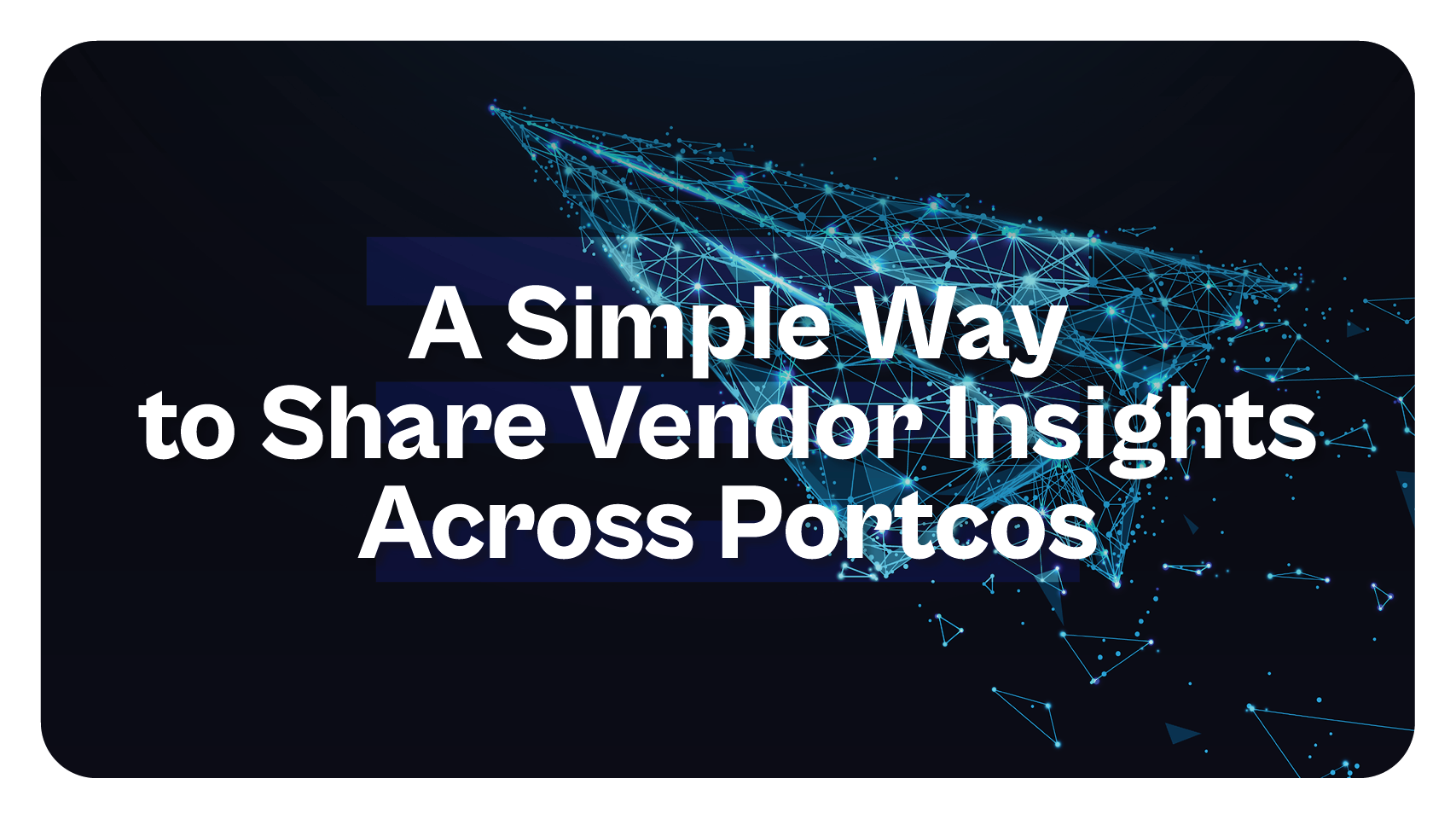
Unlock Hidden Value: Why Centralizing Vendor Data is Crucial for Private Equity Firms

Senior decision-makers in private equity firms are constantly seeking ways to reduce costs, enhance performance, and generate value for their portfolio companies. Handling a diverse range of companies within the portfolio presents a significant challenge, but technological advancements have made it more feasible. While utilizing playbooks and recruiting top talent is essential for driving efficient returns, it's not enough in today's marketplace. Equally as important as having the right playbooks is the ability to analyze where the companies are allocating their resources to fulfill commitments to customers. And that often leads back to understanding vendor relationships and getting a better handle on third-party suppliers.
When each company in the portfolio independently manages their vendors and operates in isolation, it creates significant challenges for the firm's decision-makers. This decentralized approach can result in blind spots and missed opportunities. Failing to centralize data across portfolio companies, particularly in relation to vendors and suppliers in 2024, means navigating the business without clear insight, which could lead to inefficiencies, increased costs, and overlooked opportunities for growth.
But can vendor management software really help?
Imagine logging into a single dashboard, a customized vendor management platform that shows you every supplier that all your portfolio companies use to run their operations. Now imagine having all that data automatically updated and tracked in real-time.
With the right vendor management solution, you can make this a reality.
This article will explore how centralizing vendor data can help you achieve your goals and provide practical steps to implement a vendor management solution effectively.
The Importance of Centralizing Vendor Data
When vendor data is spread out across different systems, spreadsheets, and departments within each portfolio company, it creates a situation where mission critical information is not easily accessible in one place. This fragmented approach can lead to a variety of challenges:
1) Missed Cost-Saving Opportunities:
Not having a holistic view makes it nearly impossible to proactively identify areas where better deals could be negotiated or where spending could be consolidated for cost-saving purposes. As a result, many companies could be overspending and losing out on perks that could significantly impact their P&L.
2) Inconsistent Vendor Performance:
Managing vendors and tracking their performance becomes complex when data is scattered. This inconsistency creates the risk that something might go wrong and puts a strain on relationships because issues often don't reach decision-makers until they are already out of hand.
The lack of an easy vendor management process that facilitates communication and transparency often makes it challenging to do a proper risk assessment or to determine whether pre-defined expectations are being met.
3) Increased Risk:
The decentralization of data can pose risks in terms of compliance and overall risk management. Without a centralized system, ensuring that all necessary compliance requirements are met becomes more challenging, and the lack of a cohesive view may make it harder to manage and mitigate risks across the organization effectively.
Vendor management systems play a crucial role in simplifying the procurement process. By employing the appropriate software solution, all vendor-related activities can be centralized into a single dashboard, facilitating efficient management. This consolidation offers a myriad of advantages to external vendors, the management team, and the firm's decision-makers. It allows for the generation of comprehensive insights, which can lead to improved negotiations and the discovery of new opportunities for securing better deals. Furthermore, the ability to compare vendor performance across all companies ensures greater accountability throughout the procurement process.
What The Best Vendor Management Software Should Offer You
1) A Centralized Data Repository
The right vendor management tool should act as a central hub for all your vendor data and activities. It gathers and consolidates information from different sources and organizes it in one place, making it easy for you to access and analyze.
2) Automated Data Collection
Instead of relying on manual data entry, you should have a vendor management software that automatically collects and updates all vendor information across your portfolio companies. This automation ensures data accuracy and saves a lot of time.
3) Real-Time Insights
With real-time reporting and data analytics, you can get up-to-date insights into vendor performance, spending patterns, and potential risks. This allows you to make informed decisions quickly.
4) Comprehensive Reporting
A good vendor management system should provide detailed reports on various aspects of vendor management. These reports can help you understand spending trends, compliance issues, and performance metrics across your portfolio.
5) Community building
When you invest in the best vendor management system, you should have an inbuilt social aspect to it that facilitates transparency and sharing across portfolio companies. Helping a newly acquired company access information on the best tech stack, the best vendor, and perks that other companies are receiving from their service providers is a great way to take the guesswork out of decision-making. Having this information in a centralized location saves all parties concerned a lot of time and headache.
6) Vendor Risk Management
Instead of leaving compliance and risk mitigation to the wind, invest in a solution that allows you to monitor your vendors and notice any red flags before they become serious problems. The right vendor management solutions should include built-in functionality to help your team ensure all necessary compliance requirements are met.

💡Looking for a vendor portal that will streamline your procurement processes? Try Proven for Free.
Practical Steps to Implement Vendor Management Software Solutions
Step 1: Assess Your Current Vendor Data
Start by evaluating how your portfolio companies currently manage vendor data. Identify the systems and processes in use and the gaps that need to be addressed.
Step 2: Choose the Right Vendor Management Software
Look for software that offers the features you need, such as centralized data storage, automated data collection, real-time analytics, comprehensive reporting, contract management, and vendor relationship management. Ensure it is user-friendly and can integrate with your existing systems.
Step 3: Plan the Implementation
Create a detailed implementation plan that includes timelines, responsibilities, and milestones. Ensure that all stakeholders are on board and understand the new system's benefits.
Step 4: Train Your Team
Provide training for your team and portfolio companies to ensure they know how to use the software effectively. Offer ongoing support and resources to address any questions or issues.
Step 5: Monitor and Optimize
Once the software is implemented, continuously monitor its performance and look for ways to optimize its use. Collect feedback from users and make necessary adjustments to improve efficiency and effectiveness.
Conclusion
Centralizing vendor data can significantly transform the operations of your private equity firm. In addition to the apparent advantages of cost control and enhanced operational efficiency, there are additional benefits related to value creation.
By effectively addressing the issue of decentralized data and utilizing vendor management software, your firm can access valuable, actionable insights that not only drive cost savings but also generate substantial value for the portfolio companies. This can lead to more informed decision-making and better strategic positioning within the market.



.png)






